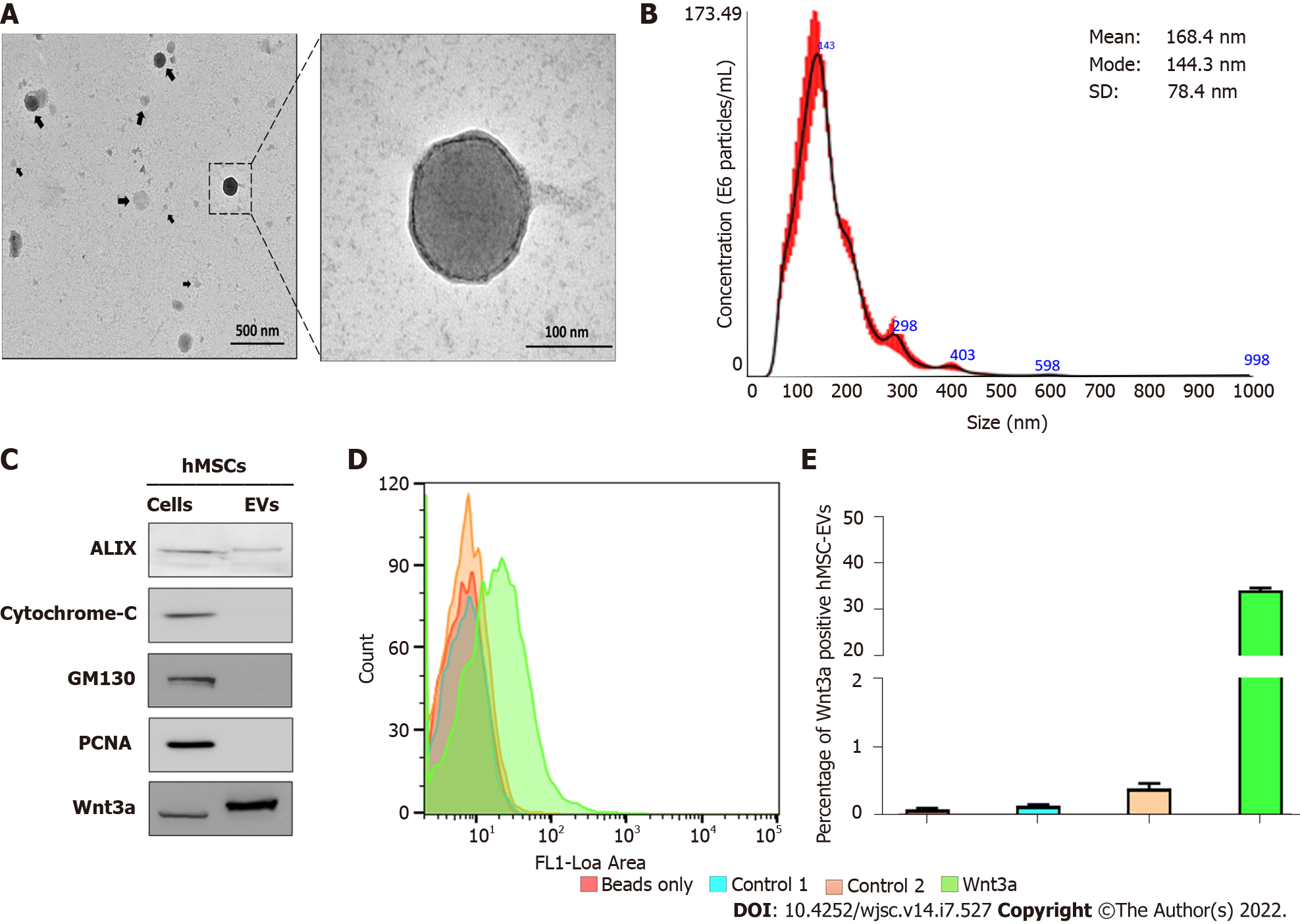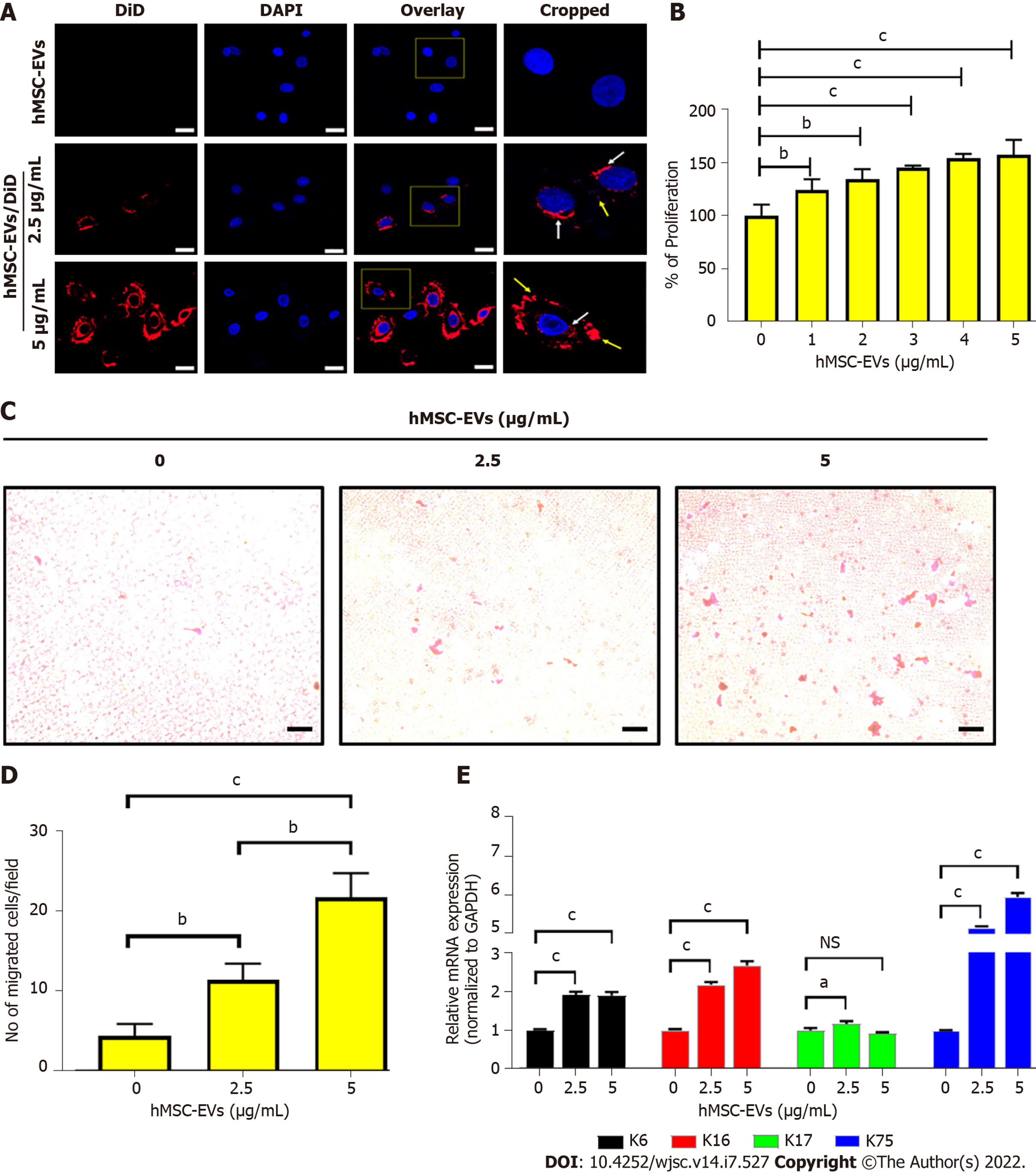Copyright
©The Author(s) 2022.
World J Stem Cells. Jul 26, 2022; 14(7): 527-538
Published online Jul 26, 2022. doi: 10.4252/wjsc.v14.i7.527
Published online Jul 26, 2022. doi: 10.4252/wjsc.v14.i7.527
Figure 1 Isolation and characterization of human mesenchymal stem cell-derived extracellular vesicles.
A: The morphology of human mesenchymal stem cell-derived extracellular vesicles (hMSC-EVs) was confirmed using transmission electron microscopy (scale bars: 500 and 100 nm); B: hMSC-EV size was determined using nanoparticle tracking analysis (n = 5); C: Western blot analysis using Alix, cytochrome C, GM130, PCNA, and Wnt3a antibodies on hMSCs and hMSC-EVs; D and E: Flow cytometry count graphs of only beads, control 1 (beads + hMSC-EVs), control 2 [beads + hMSC-EVs + Secondary fluorescein isothiocyanate (FITC) antibody], and Wnt3a (beads + hMSC-EVs + Wnt3a antibody + Secondary FITC antibody) (n = 3). The values obtained from experiments are shown mean ± SD. FITC: Fluorescein isothiocyanate; hMSC-EVs: Human mesenchymal stem cell-derived extracellular vesicles, NTA: Nanoparticle tracking analysis.
Figure 2 Interaction of human mesenchymal stem cell-derived extracellular vesicles with dermal papillae cells leads to cell proliferation and activation of Wnt/β-catenin signaling.
A: Dermal papillae (DP) cells incubated for 2 h with non-labeled human mesenchymal stem cell-derived extracellular vesicles (hMSC-EVs) (10 μg/mL) and DiD-labeled hMSC-EVs (5 and 10 μg/mL; hMSC-EVs/DiD) (scale bar: 20 μm); B: DP cell proliferation was determined using a CCK8 assay 24 h after treatment with 0–10 μg hMSC-EVs (n = 5); C: β-catenin immunofluorescence assay in DP cells after 24 h of treatment with hMSC-EVs (10 μg/mL) (scale bar: 20 μm); D: The levels of β-catenin in the nuclear fraction of DP cells treated with hMSC-EVs (5 and 10 μg/mL) with histone H3 used as a loading control for nuclear fraction; E: Quantitative real-time polymerase chain reaction results of mRNA expression of Axin2, EP2 and LEF1 in DP cells treated with hMSC-EVs (5 and 10 μg/mL) for 24 h (n = 3). The values obtained from experiments are shown mean ± SD (bP < 0.01; cP < 0.001. Student’s t-test was used for comparison). hMSC-EVs: Human mesenchymal stem cell-derived extracellular vesicles; DP: Dermal papillae.
Figure 3 Interaction of human mesenchymal stem cell-derived extracellular vesicles with outer root sheath cells leads to cell proliferation, migration, and differentiation.
A: Outer root sheath (ORS) cells incubated for 2 h with non-labeled human mesenchymal stem cell-derived extracellular vesicles (hMSC-EVs) (5 μg/mL) and DiD-labeled hMSC-EVs (2.5 and 5 μg/mL; hMSC-EVs/DiD) (scale bar: 20 μm); B: ORS cell proliferation was determined using a CCK8 assay 24 h after treatment with 0–5 μg/mL hMSC-EVs (n = 4); C and D: Phase-contrast microscopy images of migrated ORS cells 24 h after treatment with hMSC-EVs (2.5 and 5 μg/mL; scale bar: 50 μm); the quantified data of migrated cells are shown in (A) (n = 3); E: Quantitative real-time polymerase chain reaction results of mRNA expressions of keratin (K) 6, K16, K17, and K75 in ORS cells treated with hMSC-EVs (5 and 10 μg/mL) for 24 h (n = 3). The values obtained from experiments are shown mean ± SD (aP < 0.05; bP < 0.01; cP < 0.001. Student’s t-test was used for comparison). NS: Not significant; hMSC-EVs: Human mesenchymal stem cell-derived extracellular vesicles; ORS: Outer root sheath.
Figure 4 Human mesenchymal stem cell-derived extracellular vesicles treatment promoted human hair follicle shaft elongation.
A: Representative images of human hair follicles of an individual after human mesenchymal stem cell-derived extracellular vesicles (0, 0.05, and 0.01 μg/mL) and XAV939 (5 μM) treatments; B: Quantified data of hair shaft elongation on day 6 (n = 6). (aP < 0.05; cP < 0.001. Student’s t-test was used for comparison). hMSC-EVs: Human mesenchymal stem cell-derived extracellular vesicles.
- Citation: Rajendran RL, Gangadaran P, Kwack MH, Oh JM, Hong CM, Sung YK, Lee J, Ahn BC. Application of extracellular vesicles from mesenchymal stem cells promotes hair growth by regulating human dermal cells and follicles. World J Stem Cells 2022; 14(7): 527-538
- URL: https://www.wjgnet.com/1948-0210/full/v14/i7/527.htm
- DOI: https://dx.doi.org/10.4252/wjsc.v14.i7.527












